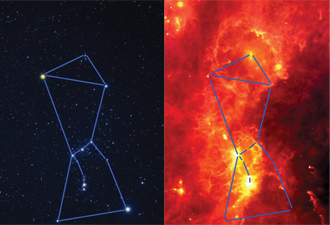| |
 |
|  |
| |  |
| | Infrared Astronomy
In 1800, Sir William Herschel discovered an invisible form of radiation just beyond the red portion of the visible spectrum. He named this form of radiation infrared ("below" red). Herschel's discovery was the first step in establishing what we now call the electromagnetic spectrum. Visible light and infrared radiation are just two of the many types of energy produced by all objects on Earth and throughout the universe. Only by studying all of these types of radiation can we characterize celestial objects and gain a complete picture of how the universe was formed and is changing.
Studying the Hidden Universe
The heat that we feel from our Sun or from a fireplace is infrared radiation (thermal energy). Even objects that we think of as being very cold, such as ice cubes, emit thermal energy. Measuring the infrared energy from astronomical objects is difficult because most of it is blocked by Earth's atmosphere. Therefore, most infrared astronomers use space telescopes to study the thermal emission from celestial objects.
The telescopes and detectors used by infrared astronomers emit thermal energy of their own. To minimize these contaminating influences, and to be able to detect the much weaker celestial radiation of interest, astronomers typically refrigerate their telescopes and instruments to temperatures near minus 269°C (-450°F) -almost absolute zero!
 Image above: The visible light (left) and infrared (right) images of the constellation Orion shown here are of the exact same area. These images dramatically illustrate how features that cannot be seen in visible light show up very brightly in the infrared. Image above: The visible light (left) and infrared (right) images of the constellation Orion shown here are of the exact same area. These images dramatically illustrate how features that cannot be seen in visible light show up very brightly in the infrared.
(Credits: Visible light image: Akira Fujii; Infrared image: Infrared Astronomical Satellite )
+ Printable Photo
Building New Stars
The visible and infrared images above illustrate the different views of the universe that can be obtained with an infrared observatory. Both images are of the constellation Orion (outlined in blue). The image on the left was made with a camera sensitive to the same type of light that the human eye or the Hubble Space Telescope can see. Prominent objects in that image are stars with about the same temperature as our Sun. The image on the right shows the same scene viewed at far-infrared wavelengths by a space observatory or SOFIA. Features that cannot be seen at all using visible light show up very brightly in the infrared. The bright yellow spots in the infrared image are "star nurseries" where thousands of stars and, perhaps, planets like the Earth, are presently forming. Embedded in these dusty clouds, the young stars are difficult to see in visible light -- but heat reveals their presence in the infrared. At long infrared wavelengths, astronomers are able to study the distribution of dust that characterizes these cocoons where star formations occur. At short infrared wavelengths, scientists can pierce through the obscuring dust and gas to reveal the young stars in the process of being born.
The interstellar medium (ISM) in our Milky Way Galaxy is the dust and gas between the stars. It originates in either violent supernova explosions or in gentler episodes where a star's outer layers are blown off near the end of its life. The ISM is the reservoir of material from which new stars form. The clouds of interstellar dust and gas are best revealed at long infrared wavelengths (about 100 times longer than visible radiation). To see the newborn stars embedded in these clouds of dust and gas, astronomers depend on observations made at short infrared wavelengths which penetrate through the obscuring dust.
+ Read More
| |
|  |
| |
 | |
 | |
 | |
| | 
SOFIA
World-class airborne observatory will complement space and major Earth-based telescopes.
+ View Photos
+ View Video | |
 |
| | 
Debut
VIPs, news media and guests celebrated the debut of SOFIA.
+ View Podcast | |
 |
|








